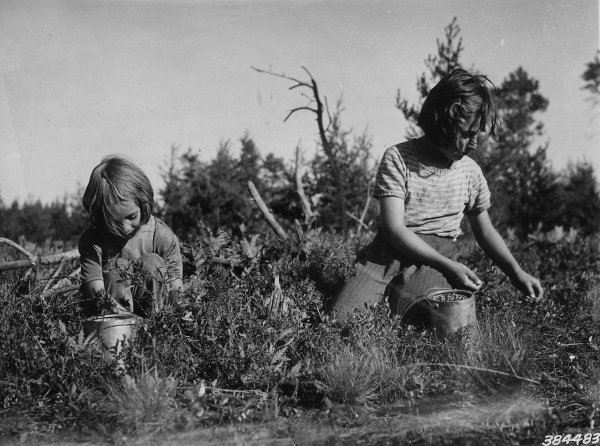
A mother and daughter picking lowbush blueberries in the Huron-Manistee National Forest
of Michigan, 1939. Department of Agriculture. Forest Service. Region 9 (Eastern Region) image.
.
If you have any comments, observations, or questions about what you read here, remember you can always Contact Me
All content included on this site such as text, graphics and images is protected by U.S and international copyright law.
The compilation of all content on this site is the exclusive property of the site copyright holder.
Blueberry Summer: Second Week
The Cultivation of Blueberries
Saturday, 11 July 2020
When I was a child one of my mother's sisters bought a bungalow in Brookfield, Connecticut. We spent our summers there. In the early years things were primitive. There were regular deliveries of the necessary ice for the ice box in which we kept food cold. The milk man delivered too. To embellish the cottage cheese and sour cream we had for lunch, berry picking was a morning activity. There was one field with high bush blueberries. A grass fire one year was followed with even better blueberries the next summer. Picking berries. Plink, plink, plink into the white enamel pail, until there were enough to cover the bottom. It took me longer than the grownups, because I ate at least as many as I picked.
As well as these high bush blueberries, Vaccinium corymbosum,
there were also knee high, lowbush blueberries, V. angustifolium.

A mother and daughter picking lowbush blueberries in the Huron-Manistee National Forest
of Michigan, 1939. Department of Agriculture. Forest Service. Region 9 (Eastern Region) image.
If you have no place to pick wild blueberries, high or low, it is certainly possible to grow your own. A sunny site, moist but with good drainage, lower nutrient levels, and a low pH - in fact, blueberries can even be grown in pots. Large ones. As was mentioned in my first entry it was Elizabeth White and Dr. Coville who discovered these important facts and began selecting superior blueberry plants. Whitesbog branched out from cranberries to also cultivate blueberries, and also propagate and sell superior, improved blueberry plants.
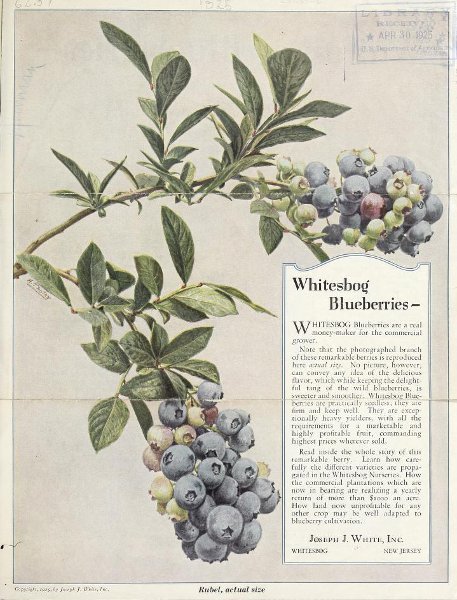
Here is the digitized cover of their catalog from the mid-1920s
offering Whitesbog Blueberries. Image in the collection of the
Henry G. Gilbert Nursery and Seed Trade Catalog Collection.
Special Collections, USDA National Agricultural Library.
It is again thanks to Dr. Coville that we also know two different cultivars will cross-pollinate and result in a better fruit set. He recognized, in 1909, that self-sterility could be an issue after few seeds and no plants resulted from selfing 'Brooks', an otherwise outstanding wild plant found near Greenfield, New Hampshire.
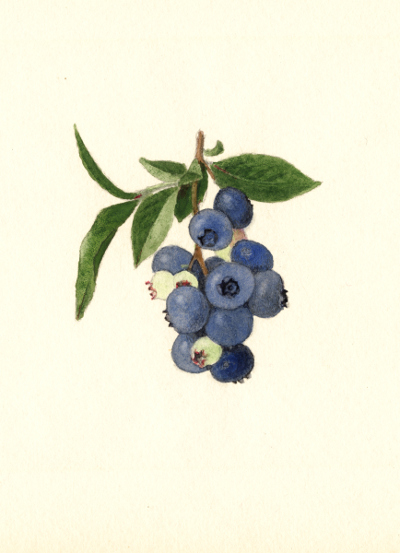
A watercolor of 'Brooks' painted by James Marion Schull in 1940,
held in the Special Collections, USDA National Agricultural Library
There is actually something more to do, to cultivate and harvest your own blueberries. We like blueberries. So do wild animals and, especially, birds. Back in Fairfield County, Connecticut my friend Ellie planted blueberries. She had good harvest the first year or two but then the birds came to feast, stripping the bushes clean. Blueberries are attractive plants. As well as delicious berries they have white, bell-like flowers and vivid red autumn leaf color. Bowing to the inevitable Ellie pruned the bushes high and underplanted them with shade tolerant perennials that enjoy the same acid soil, moist but well drained conditions, incorporating the blueberry bushes as an ornamental feature of her garden.
If you want blueberries of your own to eat, the plants will have to be netted
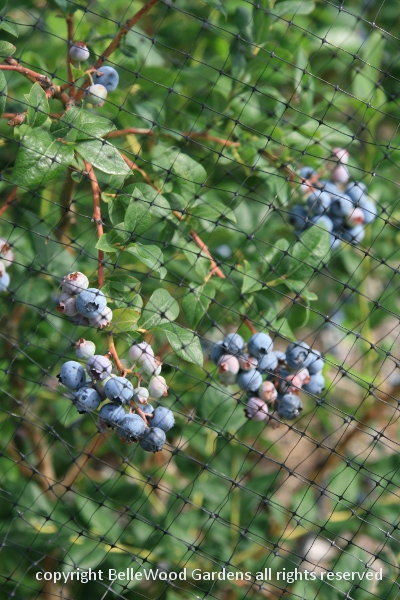
to foil the feathered thieves: robin, bluebird, blue jay, Baltimore oriole and more.
There is a local family orchard where I buy blueberries. They had
several things to consider when netting their blueberry bushes.
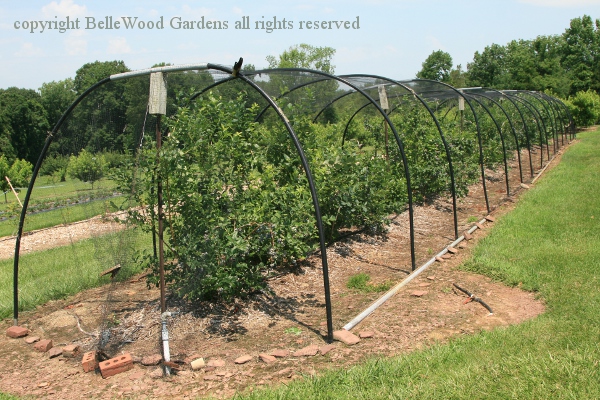
Dick made a cage system for the whole row of blueberry bushes. Simple yet elegant, and effective. The caged beds are 10 feet across and as long as necessary. Ten feet isn't really wide enough, now that the bushes are mature. When he and Mike go in to pick they're hunched over at the outside of the row, even down on their knees. When the new blueberry bushes he planted in Spring 2013 came into bearing he made the cage system 12 feet wide.

His design makes it easy to put the piping and netting up each year and take it down again after the blueberry season is over. Carefully folding the netting up and storing it away means that it lasts for about 5 years. If the netting was left up year-round the ultraviolet in sunlight would degrade it more quickly. The flexible black pipe is well piping with an inside diameter of 1 inch, slip-fitted over galvanized steel pipe with an outside diameter of 1 inch. What you have to do, he said, is check how the pipes fit together - not so tight that it is difficult to fit them together, or so loose that the black pipe could wobble around. The galvanized pipe protrudes above ground for about 12 to 18 inches.
He made the system using recycled material that he had around the place, but said that the black pipe could be bought from a well driller. There are a few internal supports. They are each fitted with a block of wood that has a slight channel to better secure the black piping as it arches over. Where the netting drapes down to the ground it is weighted down with metal pipes, bricks, stone - whatever comes to hand. And the ends are gathered together and clipped, easy to undo and get inside to harvest.
All too often when someone is looking for information about caging blueberries on the Internet they come across one of my BelleWood Gardens entries. Or, even more often, an image on Pinterest. The nice, pleasant, polite people then email me to ask for details. That's what Pam Testi did, eager to get the blueberries on her farm caged before they ripened and the birds came to feast.
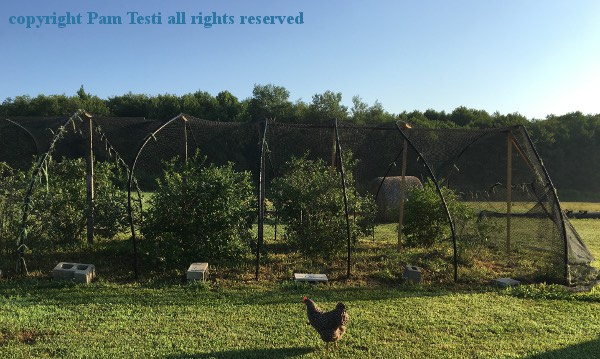
She and Matt live in northwestern Pennsylvania, where they have fruit trees and a double row of blueberry bushes. After I replied to her inquiry, she decided to use some trampoline netting that they happened to have on hand. She mentioned that they have had the netting for years. Didn't remember what they paid for it, other than that was a more expensive one but is still like new after all these years.
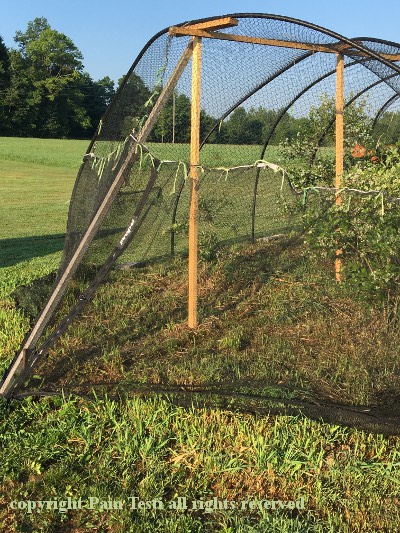
Pam wrote, "I think we stretched the arch as far as you could and still get the desired height and coverage. The black plumber's pipe cost $32/roll. We used 2 rolls. We used boards we had around the farm, and it looks like we have a decent crop this year . . . We often get frosts that take a toll on fruit trees where we live, but this year we had a cool late spring. Summer came gradually with no surprise frosts. I'll be picking my first berries tomorrow morning for breakfast! I can't wait. "
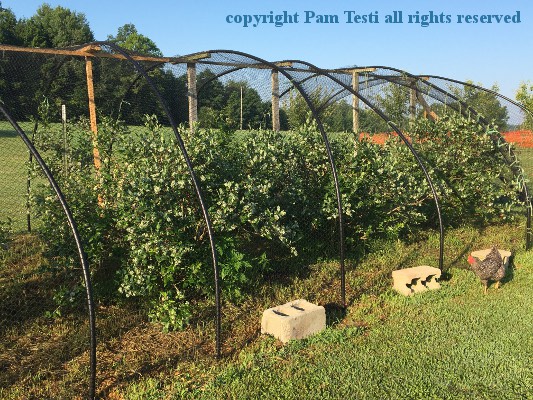
.
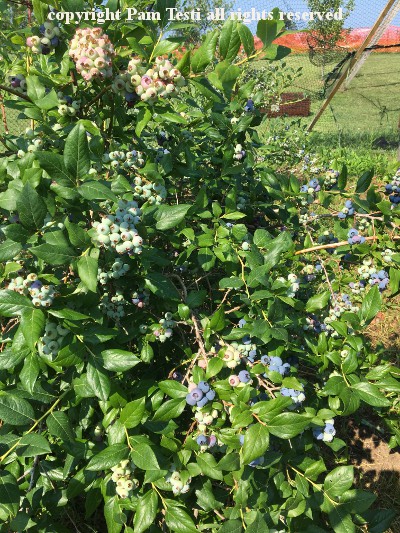
Yesterday Pam sent me an image with a very happy message line,
"Loaded! Now that the birds aren't eating them."
My friend Joan wrote "And, speaking of blueberries - we drove to Pemberton New Jersey on Wednesday [8 July] - not to pick, just to pick up - bought 30 pounds of blueberries already picked. Washed, dried and froze most of them - made blueberry muffins and a mixed berry tart. Can't beat the tasty summer fruits."
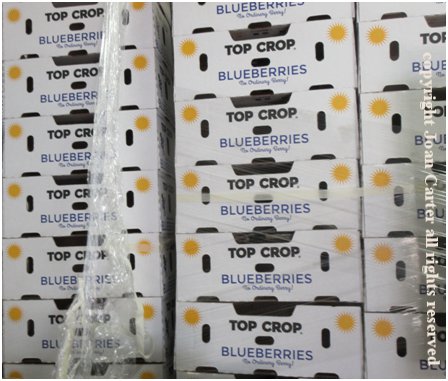
A quart of blueberries, Joan said, weighs approximately, 18-19 oz. depending how full you make the container so she estimates they got around 25 - 26 qts from their 30 pounds. They paid $2.20 / pound for the picked berries. It would have been $2 / pound for U-pick berries.
The local Shoprite supermarket has a special offer for blueberries with an online coupon. A tray of 6 quarts of blueberries, limit one per customer, for $6.99. Blueberry summer, indeed.
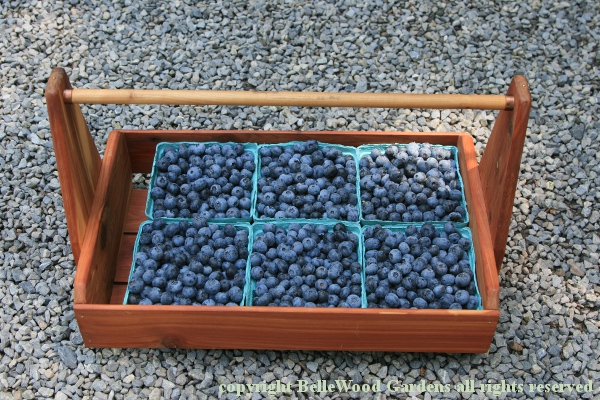
Back to Top
Back to July
Back to the main Diary Page